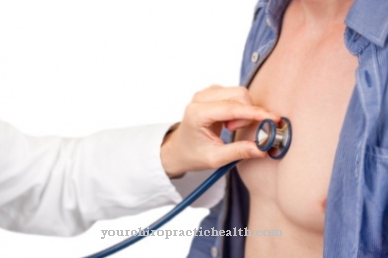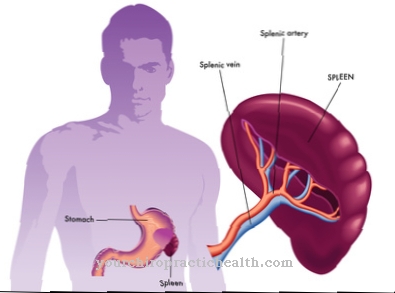Brown spots on the skin have different causes. Not all types of this phenomenon need to be addressed. Recognizing the type of brown spots present is often only possible for a specialist. Danger to life from skin cancer.
What are brown spots on the skin?

Brown spots on the skin can have various origins. The freckles are smaller light spots with a yellowish to brownish color. They are especially common in blond or red-haired people with a fair complexion.
The freckles increase in summer when the skin is exposed to the sun's UV light. In winter, these pigment disorders sometimes even completely disappear again. Another form of brown spots on the skin are age spots, which are mainly found on the back of the hand, forearms or on the face of older people.
In addition to these two benign forms of brown skin patches, there is also the malignant form - lentigo maligna, which is not always easy to recognize. A dermatologist's examination provides certainty in such cases and should be carried out regularly if there are brown spots on the skin.
causes
The causes of brown spots on the skin are many. On the one hand, genes determine how we look and what individual characteristics each person has. This also applies to the appearance of the skin. The sun's UV light also has a significant influence on freckles and age spots.
Freckles are caused by hyperpigmentation. Certain cells in the skin called melanocytes produce the pigment melanin. The melanin is stored in the other cells - the keratinocytes. The pigment lipofuscin, which is also known as age or wear and tear pigment, also plays a role in age spots. The freckles are most likely an innate genetic variation. Age spots, on the other hand, are a symptom of old age.
Diseases with this symptom
- Age spots
- Lentigo maligna
- Pigment disorder
- Melanoma
- Skin cancer
- Pityriasis versicolor
Diagnosis & course
Recognizing brown spots on the skin is easy with freckles and age spots. However, it is difficult to distinguish between malignant phenomena. There are many types of skin cancer, and the number of cases each year is increasing.
Skin cancer is also known as malignant melanoma. This is where the cells that make melanin degenerate - the melanocytes. This form of cancer is very aggressive. It leads to rapidly growing growths, which can also lead to metastases in the lymph nodes and internal organs. A reliable diagnosis of what kind of skin condition is involved can only be carried out by a dermatologist.
The course of freckles and benign age spots, on the other hand, is unproblematic. Another type of proliferation on the skin is the mole. These mostly light or dark brownish spots, also called birthmarks, are mostly benign. However, the course is problematic from a cosmetic point of view due to the spreading and growing growths.
Complications
The following complications can occur with brown spots on the skin:
- The brown areas get bigger and their color and shape change.
- The surface is no longer smooth, but rather rough and flaky. It can catch fire.
- Pustules and nodules develop on the brown spots.
- The edge area dissolves into fibers and is no longer clearly delimited.
- The brown spots are painful and itchy, turn red, or blister.
- Skin rashes develop.
If changes in the brown spots are not treated by a doctor or treated too late, skin cancer, especially melanoma, can develop. A melanoma (black skin cancer) is characterized by its changed color and a changed surface with irregular edges. Melanoma often occurs on the lower leg, but also on the hips, shoulders and arms, on the back or on the face.
Precursors of melanoma, for example melanotic precancerosis or lentigo maligna, can also occur.
With a timely diagnosis, major complications related to brown spots on the skin can be avoided. If a melanoma is recognized late, however, offshoots may have already formed in internal organs, so that the prognosis for the patient is serious.
When should you go to the doctor?
The appearance of the skin is genetic. In addition, it is affected by UV radiation, chemical substances and hormones. Not all brown spots on the skin require treatment. The best known are freckles, which occur as pigment spots in very fair-skinned people. They do not indicate disease, but are a genetic freak of nature.
We also know brown spots on the skin as age spots. These skin changes are also harmless and are mainly found on the face, hands, and forearms. In the case of age spots, the wear pigment lipofuscin accumulates in the skin cells. Many sufferers are bothered by this and have pigment spots lightened. Increased pigmentation can occur in adults after extensive sun exposure. This occurs mainly in connection with medication.
Those affected should avoid direct sun. The number of moles can increase with age. These are also benign, but optically disturbing for many. An increased number of liver spots is not a reason to see the dermatologist. If, however, the skin changes color unexpectedly in one place, a doctor should follow. Changes to previously flat moles, which are now raised and larger, are particularly critical. Such cell changes can be an indication of skin cancer. Since skin cancer also occurs in many forms, medical clarification is always required.
Doctors & therapists in your area
Treatment & Therapy
The fewest brown spots on the skin need treatment. In particular, freckles and age spots are usually not a threat. Nevertheless, due to the associated sensitivity to UV light, it is recommended that people with freckles not expose their skin to much sunlight.
People with freckles are more prone to sunburn due to their light skin type. Annoying age spots and liver spots can be removed with medical laser therapy, for example. In addition, acids such as fruit and vitamin A acids as well as preparations containing rucinol have a lightening effect. The treatment of the liver spots makes sense when a severe infestation is present or is to be expected.
The proliferating, spreading property of this skin phenomenon makes it necessary in some cases for cosmetic reasons to stem the spread early. However, laser therapy, surgical removal or freezing only lead to short-term success, as the moles keep growing back due to the genetic cause. Treatment cycles of one to two years are therefore indicated.
If the infestation is very large, laser therapy is the most effective form of treatment. It can be performed quickly on an outpatient basis by a doctor under local anesthesia. In the case of malignant skin cancer - malignant melanoma - immediate medical treatment is essential. The faster this growth is removed as a whole, the greater the likelihood that cancer cells will not be able to spread through the bloodstream or lymph fluid in the body and cause damage.
prevention
Consistent UV protection is usually suitable for preventing and lightening browing spots on the skin on freckles and age spots. This measure has also been shown to significantly reduce the likelihood of developing skin cancer.
Here it is especially important to avoid any sunburn. In Germany, all persons with statutory health insurance from the age of 35 are entitled to an early skin cancer screening examination every two years.
You can do that yourself
For all brown skin spots that are due to a disturbance in the storage of the skin pigment melanin, caution is called for when it comes to direct sunlight. However, the UV-B component of sunlight has no effect on the development of age spots and spots that are based on metabolic and hormonal disorders. Likewise, some birthmarks or nevi do not respond to sunlight.
As a rule, there is a cosmetic problem for the brown spots, which can be overcome in a number of ways - even without a skin laser. A tried and true home remedy for lightening brown spots on the skin is lemon juice. The lemon juice is dripped directly onto the skin patch or applied with a cotton ball. The exposure time must be at least half an hour before the lemon juice is washed off again. The treatment is carried out twice a day over a period of several weeks. A little patience is required.
As an alternative to lemon juice, onion juice, buttermilk, apple cider vinegar, horseradish or even castor oil can be used. One agent that, in addition to acids, also contributes various enzymes to combat brown spots and age spots is papaya. A little papaya pulp is simply crushed with a fork and applied directly to the skin spots. Here, too, the exposure time should be at least 30 minutes and the treatment should be continued for several weeks to months.

.jpg)

.jpg)


.jpg)

















.jpg)



